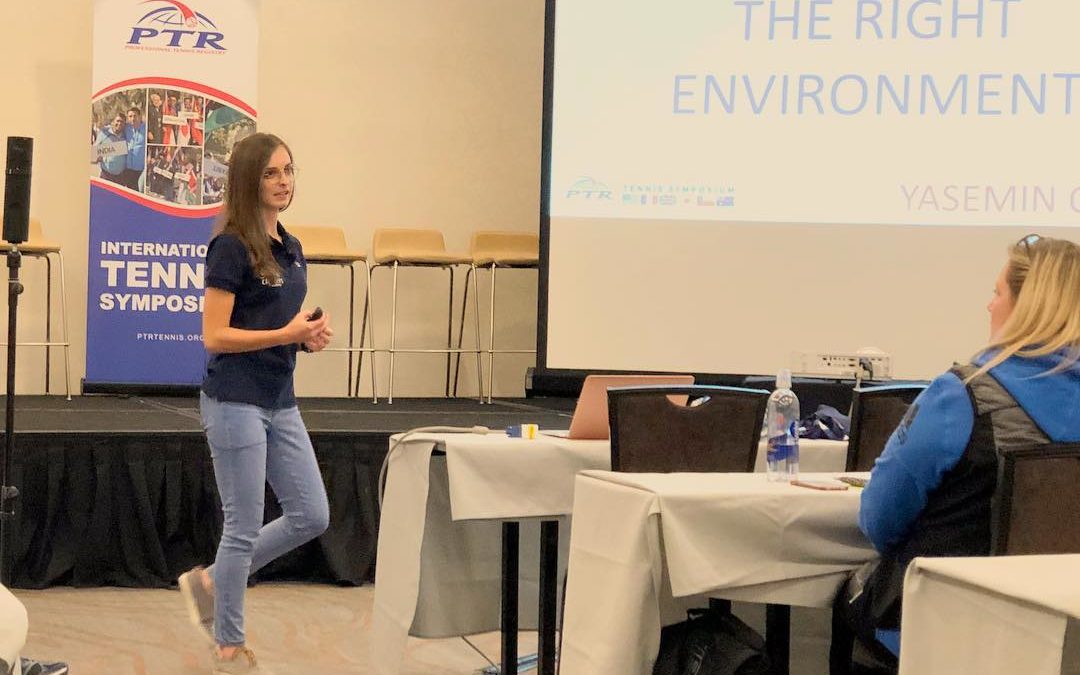Building a positive on-court culture among athletes is vital to the success of any tennis program, but this culture cannot be built solely on the tennis courts alone. According to Kim Clijsters Academy Assistant Manager Yasemin Ozsoy, creating an encouraging and upbeat environment on the court originates from the ways in which an academy operates its business.
Tennis has been a part of Ozsoy’s life since she was just five years old. Despite finishing her competitive career at 16, she has never once took a break from the sport. At 18, she found herself embarking on what would be the start of a life-long career in tennis after a five-year-old student reinvigorated her passion for the sport.
Over the past eight years, Ozsoy has held various jobs within the industry, ranging from Senior Coach at Tennis Australia, Sponsor Relations Manager for both ATP and WTA tournaments, owner of her own Elite Tennis Management business and now with her current position with Kim Clijsters Academy.
Ozsoy recalls feeling the urge to move into a new role early last year, so naturally, she sought advice from some of her closest mentors. “As young females, we always want to keep growing and we feel stagnant quite quickly,” Ozsoy explained.
Through her mentors, Ozsoy was able to connect with Carl Maes, Academy Director at the Kim Clijsters Academy. Initially, she was hired to be a ghost writer for Maes’ ‘Female Tennis Pathway’ platform, which focuses on assisting the development of female tennis athletes. However, her role has since evolved into also assisting with management, administration, coaching and international relations at the academy.
From the first day she arrived, Ozsoy noticed something different about the culture at Kim Clijsters Academy. “When I arrived, I felt at home. This is something we hear a lot from our clients, it’s a very warm feeling. I went in, and I did not feel like a foreigner or a visitor,” she recalled.
“I added a different energy that they didn’t have before, but I fit in almost immediately. I felt like I had already been working there for a long period of time,” said Ozsoy. “ It’s probably because they are a boutique-style academy and it allows them to be accountable for every client, visitor, parent, you name it. That’s one of their greatest qualities and I’m very grateful to be working with them.”
Unfortunately, not every academy fosters the inclusive, client-oriented environment that the Kim Clijsters Academy has become known for. Particularly for large-scale academies, creating a sound culture amongst all coaches, employees and students can be quite difficult.
“When you have such a large scale, the quality often has to be removed because of the large volume. Coaches are unable to focus on each player the way they should. It’s more of a robotic academy environment,” Ozsoy explained.
“Kim Clijsters is very much a high performance academy and an all-level based academy, but somehow, due to the coach-to-player ratio, you don’t feel like you’re just a number in the academy and that’s very rare to do,” said Ozsoy. “It takes a lot of time out of us, and there’s a lot of extra work that we do to make sure our quality stays number one.”
Through working at multiple academies across the globe, Ozsoy has learned how best to build culture among many different backgrounds and personalities. “I’ve learned to observe, see how the kids react and allow them to come to me, rather than forcing the connection. With this new generation, the kids are checking your social media before they even meet you. Parents and kids already make a judgement before you build a connection. Traveling around the world, it’s important for any new coach to observe how the coaches are talking to their kids,” she said.
By experiencing the cultural differences in coaching styles across the countries she has worked in, Ozsoy has come to realize the importance of creating a conversation between student and coach. “Here in Belgium, we are putting the athletes first before our own needs. I think that’s the true meaning of a coach, putting someone else’s needs before yours,” she explained.
“Culturally, you have to adjust, take your time and be respectful. You have to put the customer first,” Ozsoy urged. “It’s really interesting how different cultures and athletes force you to learn different ways of coaching. That’s been my biggest growth experience as a coach.”
Another monumental area of growth Ozsoy has experienced throughout her time at Kim Clijsters is working with Maes on the ‘Female Tennis Pathway’ program. “Carl has taught me that girls are very goal-oriented. The way he communicates our drills is very much female-oriented, giving girls a choice and giving them an environment to grow and figure things out on their own,” she said.
“An error we have as coaches is that we think we have the solution to everything. We don’t allow our athletes to figure things out on their own,” Ozsoy explained. “In the end, when they go to play matches, they need to have those skills. We can’t come in and tell them what to do. At Kim Clijsters, we provide the tools to allow females to become independent on their own and figure out their own game styles.”
Finally, if there is one lesson Ozsoy has for coaches from the experiences she gained throughout her career, it is to be adaptable. “Allow yourself to adapt to the culture or the needs of the new generation. I think a lot of the academy directors are stuck in an age that’s maybe not so responsive to this new generation.”
“Have a more adaptable culture and brand because you only have one shot. As soon as you have an image, it’s difficult to change that,” Ozsoy urged.

